“Dance music for a generation of buffered streams. Tight packets of funk/house/disco/pop bounced together like aliasing-mulch. INTERNET MUSIC. A manifestation that can only happen in the multimedia-rich virtual-reality of NOW.”
So run the liner notes for Power Nap’s 2012 release Just Do It – and they’re sentiments that could equally apply to the New Zealand label it came out on: Crystal Magic Records.
Conceived by indie artist Fraser Austin along DIY lines, Crystal Magic put out around 60 releases between 2010 and 2015. Perhaps best known for launching vaporwave artist Eyeliner, the label’s catalogue encompasses much else, from Frase+Bri’s twee pop and Golden Axe’s lo-tech dance tracks, to the spooky electronica of Little Phnx and the bubblegum punk of Perfect Hair Forever. A thread connecting all this together is the cultural rewiring wrought by the Internet since the mid-1990s. Crystal Magic was not only an internet-based label, the musical aesthetics, the artwork, album concepts – even the CD-Rs it released – can be seen as the products of digital-native sensibilities. It’s music of and for our digitally networked times.

Crystal Magic Bandcamp website snapshot, September 2010. Banner designed by Chris Cudby. - National Library of New Zealand web harvest
Beginnings
The Crystal Magic timeline begins in Christchurch in the mid-2000s. Fraser Austin was then in his early twenties, already with band experience under his belt. According to musician William Daymond (Terror of the Deep, AXEMEN), both he and Austin had been something of “outcasts” while attending St Andrew’s College in Christchurch. Influenced by the music of David Bowie and Placebo, Austin had put together a band for Rockquest, going on to play guitar with Daymond in The Chase.
During 2005, he was in Timaru working at the fabled record shop Radiant Records, which had become a destination for visiting bands during the first years of the A Low Hum national tours. As Austin told RNZ’s Emma Smith in 2014, it was during one such visit that he had extolled the virtues of his current band to A Low Hum founder Ian Jorgensen (aka Blink); one thing led to another, and he was invited to perform at a Christchurch gig a week later. Trouble was, Austin didn’t have a current band. Seizing the moment, he put together a set of synthpop-style songs.
“I grew up through the 90s home computer generation,” he told Black Forest Magazine in 2013.
Drawing from the electronic sounds of 1990s PC games and inspired by the live show of A Low Hum act Disasteradio, the guitar was put aside for a live rig combining Casio keyboard and Commodore 64 computer.
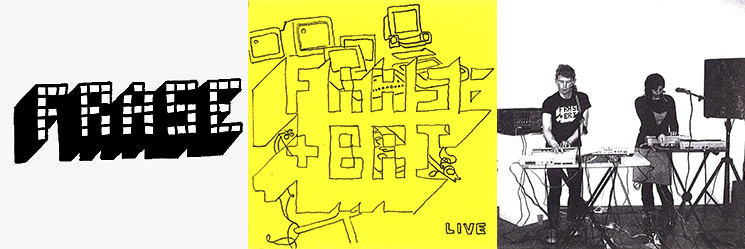
Frase, Diskette (2006); Frase+Bri, Live @ The Dux (2006); Frase+Bri, Frase+Bri (2006)
This new solo act, Frase, was the seed for Crystal Magic. The first three releases associated with the label are by Frase and the duo Frase+Bri, formed with Bri Yaakoup (ex-The Pickups), which were originally sold as homemade CD-Rs at gigs. By then, Austin had moved back to Christchurch. “During that time,” he recalls, “the idea was full hardcore DIY punk show ideals, our distro would be at the shows we put on.” It is on the sleeve of Frase+Bri’s self-titled 2006 EP that the Crystal Magic brand first appears. The name itself arose from Austin’s teenage interest in esoteric magic and the occult, the hand-drawn logo taking partial inspiration from the lightning bolt of esteemed New York dance label DFA.

Crystal Magic logo from the back sleeve of Frase+Bri (2006)
Christchurch was home to a vibrant indie music scene at the time, represented by acts such as Shocking Pinks (later released on DFA), Pig Out, and The Tiger Tones. Frase+Bri, with their electronic keyboards and “sad-wave” lyrics, cut a distinctive profile and went on to feature on several A Low Hum national tours. These were busy years for Austin, who also played in House of Dolls, Pig Out, and other groups. It wasn’t until the Christchurch scene began to slow in 2010 that he had time to dust off the Crystal Magic concept again. By then he was working at Galaxy Records with Tim Baird, who had run Pinacolada Records: more good contacts and experience to help Austin kickstart his independent imprint into life again.
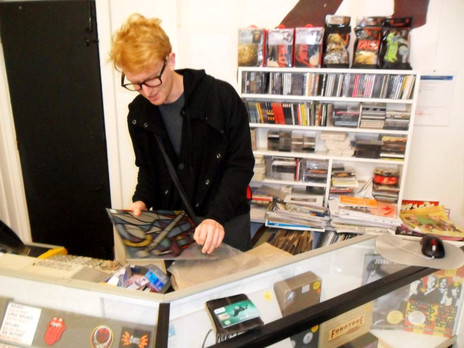
Fraser Austin working at Galaxy Records, Christchurch, 2010. Photo by Tim Baird. Creative Commons BY-NC-ND 4.0.
Reboot 2010
Another catalyst for Crystal Magic’s reactivation was Golden Axe. This Auckland duo of Chris Cudby and Daif King had been making their beat-driven lo-tech music since 2004, self-releasing on their JFBS label and performing on the A Low Hum tour circuit. During a visit to Christchurch in the mid-2000s, Cudby had been impressed by the Crystal Magic logo he’d seen pinned up on the wall of Austin’s flat. “It stuck in my mind for ages,” he remembers.
Golden Axe had gone down a more pop-oriented route for their 2010 LP Fantasy Footwork and wanted the album to have a “proper” release: that is, at least bearing the imprimatur of a record label. Crystal Magic seemed a good fit, plus they hoped their album might even help promote their friend’s enterprise too. Fantasy Footwork CDs and cassettes were sold at gigs, also being available for mail-order – along with a digital download – through Crystal Magic’s new account with the platform Bandcamp (at this point, not yet the indie music juggernaut it would become). Cudby and King would go on develop their own solo acts for the label and recommend other artists join the Crystal Magic roster. Elam art school-graduate Cudby designed the label’s first Bandcamp banner too and, a couple of years later, compiled the Crystal Magic sampler Critical Hits (2012).
Other acts that appeared on Crystal Magic during the 2010 reboot year included Futuresports (an older Cudby side project) and Dorkwind (Daif King and Ryan Bennett). The label also continued to serve as an outlet for Austin’s prolific creativity. He renamed his synthpop act Secrets and, around the end of the year, launched another identity, Feelings, for which he returned to more guitar-based sounds. Both aliases afforded Austin distance to explore the stereotypes and formulas of indie music. Devising artistic personae to add satirical layers to the music is an approach that crops up across the Crystal Magic catalogue.
The look of Crystal Magic was also evolving in 2010. Early releases featured artwork that tended to pay homage to the fanzine/comic-book stylings of 1980s hardcore packaging. But by the end of 2010, a more 21st century aesthetic was emerging, a kind of digital-age-DIY first seen with covers by Golden Axe (Free Time) and Secrets (SCRTS). It was an aesthetic that presaged much about the label’s future direction.
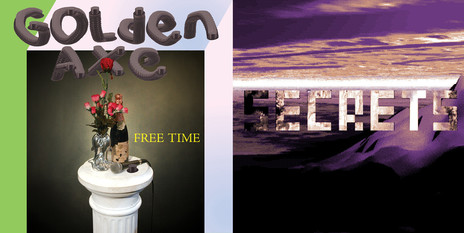
Golden Axe, Free Time (2010); Secrets, SCRTS (2010)
The year 2010 also brought tragedy and change to Christchurch, with the earthquake in September, followed by another in February 2011. These disasters devastated much of the city and led to the loss of 185 lives. Writing about the Christchurch music scene, James Dann sees the quakes as the end bracket for the 2000s band era. As it happened, Austin had already moved to Sydney with Bri Yaakoup the day before the second quake.
Vaporwave
Keeping communication lines back to New Zealand open with email and Gchat, the next two years would be Crystal Magic’s busiest, with a new release coming out every six weeks or so. Production standards also went up. “I went full amateur pro,” Austin remembers, “and bought a very expensive (for me) A3 printer for creating merch and CD sleeves.” The CD-Rs he burned himself. More emphasis went on promotion too, music being sent to magazines and websites for review, plus college and indie radio in the US such as New Jersey’s renowned WFMU station who had championed Flying Nun in earlier decades.
Alongside Crystal Magic’s cottage-industry production line was a deepening engagement with innovative zones of Internet culture. As the 2000s gave way to the next decade, new underground music styles had been coalescing online, notable examples including seapunk, witch house, and chillwave. These “Internet genres” were influenced by the environment of Web 2.0: MP3 blogs with rips of obscure old records, chat boards such as Reddit and 4Chan, and the visual mashups scrolling past on sites such as Tumblr. Audiences for these musical subcultures congregated online rather than geographically, leading to artistic cross-pollination between people logged-in around the world. Along with New Zealand music blogs such as Einstein Music Journal (2006-2012) and Rose Quartz (2007-2013), the denizens of Crystal Magic became wired into this digital ecosphere.
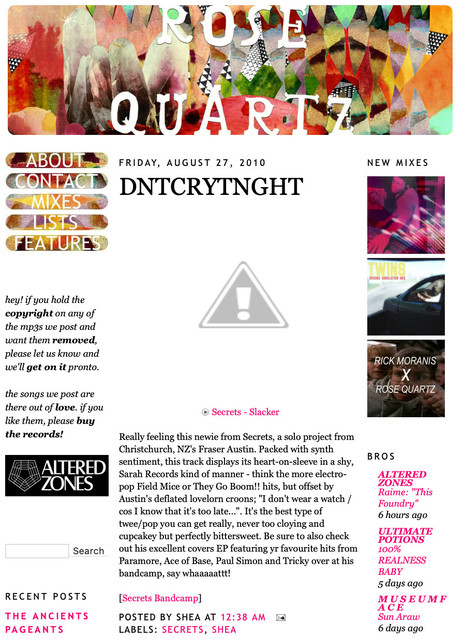
Coverage of Secrets, SCRTS (2010) on the music blog Rose Quartz: Internet Archive web harvest. Includes a badge for Altered Zones, a short-lived 2010-11 spinoff of Pitchfork which aggregated posts from experimental music blogs, including Rose Quartz.
The apex of Crystal Magic’s ventures into Internet music was vaporwave. A retro-futurist genre, vaporwave looks back to the utopian futures envisaged in the late-1980s and 1990s. Drawing inspiration from the consumerism, new technology, and corporate branding of this era, including experiences of the early World Wide Web, the genre recreates the feel of those times with a mixture of nostalgia, surrealism, and irony. Originating in obscure blog sites and LastFM tag clouds, vaporwave now boasts a sizable following and host of affiliated labels.
Early examples of what would come to be identified as vaporwave were released in 2011 by US artists such as James Ferraro and Macintosh Plus. Almost simultaneously, artists on Crystal Magic were scouting out similar territory – an antipodean parallel that the UK critic Adam Harper would later dub “convergent evolution.” These releases included No Worries by Power Nap (Chris Cudby ft Caroline Sturgess) and Later Dood by Daif (Daif King), both issued mid-2011, along with another Fraser Austin project, Real Player 7, which debuted in February 2012 with REAL. Because the term “vaporwave” was not widely used until later that year, other Bandcamp tags were coined to evoke the unique flavour of these Crystal Magic records: corporate jazz, office interiors, shareware, digital realism, post-pop.
The Crystal Magic album that ended up getting the most attention in this budding genre was High Fashion Mood Music (2012) by Eyeliner, an alias for synthpop artist Luke Rowell, who had already achieved local success as Disasteradio. Rowell had developed Eyeliner’s stripped-back sound while working with artist Bronwyn Holloway-Smith and filmmaker Simon Ward on the film Destination Pioneer City, which takes the form of an infomercial for a colony on Mars. Paying homage to music of the elevator, the shopping mall, and the cheap TV advertisement with catchy tunes and campy wit, High Fashion Mood Music is now regarded as an all-time vaporwave classic. Released in June of 2012, the album was used by Adam Harper in webzine Dummy as a showcase demonstration of vaporwave’s uncanny fusion of sincerity and irony. Harper went on to commend other Crystal Magic artists and later praised the label’s “witty and mesmerising visual style” on the Electronic Beats website.

Eyeliner, High Fashion Mood Music (2012) and LARP of Luxury (2013).
Crystal Magic put out more New Zealand vaporwave over the next couple of years, including Eyeliner’s follow-up LARP of Luxury (2013), Keep Splashin’ (2013) by Splash Club 7 (Jamie Dickson), and more from Daif, Power Nap, and Real Player 7. The label also reached beyond New Zealand shores to release work by US-based artist Power Windoze (Angel Marcloid) and Mensa Group International, a duo thought to be from either America or France, though no one seems entirely sure. Conversely, tracks by Eyeliner, Secrets, Golden Axe, and Lttle Phnx ended up on compilations from overseas labels such as AMDISCS and Fortune 500.
Artwork and extras
A compelling aspect of Crystal Magic’s catalogue is the digital feast for the eyes it provides. Many of the covers (created by Austin, King, and others) are computer generated, with Austin’s artwork often featuring digitally rendered humanoids reminiscent of the slightly creepy avatars of Second Life, the online virtual world created in 2003. Other releases sport the clean minimal look of tech-product packaging.

Secrets, You Only Tell Your BFF (2011, cover: Fraser Austin); Real Player 7, Opportunity (2013, cover: Fraser Austin); Daif, EZ Street (2012, cover: Daif King); Wundercastle, Straight Up Leisure Time (2012, cover: dawnmarble).
This “corporate uncanny” style (as Austin describes it) carried over to Crystal Magic’s digital posters, GIFs on blogs, press releases, and other operational areas, including the label’s website. Crystal Magic had started out with a Blogspot site, but as Bandcamp became established as an all-in-one platform for independent music, Austin increasingly used its templates to engage in deadpan roleplay around the label (always run on a shoestring) having a kind of “corporate” identity. At the start of 2012, Crystal Magic became Crystal Magic Records (CMR), with a redesigned logo that emphasised a more anonymous institutional quality on Bandcamp.

Digital posters by Fraser Austin. The 2011 Secrets gig poster (from National Library of New Zealand web harvest) references the famous “After Dark” flying-toaster screensaver of the early 1990s coupled with a digital Adam (after Michelangelo) who eerily seems to require no spark of life from God. The “A Very Vapor Xmas” poster from December 2012 advertises one of the earliest vaporwave livestreams.
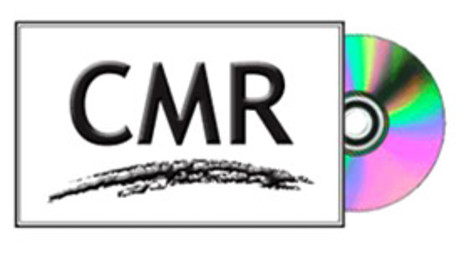
Crystal Magic Records logo, introduced in February 2012, taken from a National Library of New Zealand web harvest of the label’s Bandcamp page (July 2012).
Also in keeping with the retro-tech aesthetic, CMR put out physical-format editions sold by mail order, mainly CD-Rs, with a handful on cassette. Handcrafted in small runs (sometimes less than 20 copies) they can now be quite hard to come by. They can feature alternate track-listings and variant artwork from the digital download versions, and some have quirky packaging. The Feelings EP Feeling Good… Nah, Suck! (2010), for instance, was released on a rectangular business-card sized CD-R, while later discs pay homage to the 1990s fad of including interactive content on CDs. Pyrexia (2014) by Lttle Phnx features a dating sim game featuring a “Lttle Phnx” character and Japanese text-prompts, while Daif’s new age-influenced album 2017 (2014) includes an interactive Macromedia Flash animation with images of King assuming a range of amusing poses and props.

Packaging and rectangular CD for Feelings, Feeling Good… Nah, Suck! (2010)
Other releases
Other notable releases from CMR’s peak years include outstanding EPs by two ex-members of The Tiger Tones. Straight Up Leisure Time (2012) by Wundercastle (Mark Holland) explores a vein of hyped-up club music, while James Grant contributed the house-influenced electronica of Spelunks with Serenely Skeptical (2013). Both would later issue recordings on the Vancouver-based 1080p label, run by another Christchurch music alumnus, Richard McFarlane (of the Rose Quartz blog). Another intriguing one-off is the goth-pop of :Total Recall (2012) by Thought Creature (Will Rattray of Fantasy Fiction Records and Danny Brady of Death and the Maiden). Unfortunately, much of this material is now available only as isolated tracks, precarious fan uploads on YouTube, or not at all.
Other notable CMR releases include the album D’esprit Luvrs (2013) and EP Pyrexia (2014) by Lttle Phnx, an alias for Lucy Beeler. The name comes from her Chinese middle name 小凤 (Xiǎo Fèng, which can be translated as “Little Phoenix”), given to her before she was adopted. After early attempts at composing on guitar, Beeler had begun using the iOS application GarageBand to experiment with a witch house-type sound. Volunteering at the Auckland venue Audio Foundation, she came into contact there with Chris Cudby, who recommended CMR as a potential musical home. Being part of the Crystal Magic community, she found, “gave me confidence to perform and make music.” If the electronic music scene could sometimes feel a “dude-dominated field,” CMR had a more welcoming, whimsical vibe. Drawing from 1980s J-pop and new age, Lttle Phnx’s music for the label uses a synth-vocal palette to summon up a sense of dreamlike emotions and digitised natural environments.
One of the most prolific acts on CMR turned out to be Perfect Hair Forever, the brainchild of Auckland-based Joe Locke. The name (later shortened to P.H.F.) was taken from an adult US animation series that aired on the Cartoon Network in the early 2000s. Locke was another Golden Axe-inductee into CMR, meeting King at TV3 where both worked digitising old video tapes. Discovering they had crossover interests in noise music and the burgeoning aesthetics of Tumblr, Locke shared some of his bedroom musical efforts and “[Daif] was like, you should hit up Frase!” Beginning a six-album run on CMR with OK COOL (2012), the music of P.H.F. has something of the spirit of The Ramones’ bubblegum-brat punk, filtered through lo-fi indie and sample culture: “laptop speakers punk rock” as Fraser Austin describes it. Strewn with vivid and sometimes violent fragments of American popular culture, Grind State (2015) and Soft (2015) presented a smoother sound that is no less unsettling. Like Beeler, Locke regards Austin and Crystal Magic as having provided formative supportive for his music: “this little community of people … all super supportive and not really knowing where we were headed but having a similar ethos.”
The End
In March 2014, CMR released a second label sampler, Critical Hits II, that reviewed the output of two busy years for the label. Hereafter the rate of releases slowed considerably. Austin had shifted back from Sydney to New Zealand, life was moving on, and, after five years, the operation was becoming more than he could commit to any longer. The final release was a brilliantly mordant vaporwave-adjacent EP by SoundCanvas Ultra (Brandon Sayring) in October 2015, followed shortly afterwards by a valedictory thank-you note on the label’s website. Austin wrote:
“Roleplaying business-label executive led to me running a label that not only occasionally tripped over the zeitgeist but also at times enabled artists to buy either a takeaway coffee or chip away at their rent. We faked it enough – not to make it – but to at least not give up.”
The CMR website remained online in streaming-only mode until late 2016, when Austin finally switched it off.
Most artists in the roster subsequently moved their music to other Bandcamp accounts or platforms. Secrets and Power Nap still put out occasional releases, with much the latter’s CMR output compiled on the 2019 AMDISCS release Shaped Canvas. Daif King moved on to other ventures, including singing and playing bass with speed metal group Stälker. Lucy Beeler occasionally releases music under the alias Feng and collaborates with Fraser Austin for the guitar-based project Slow. Eyeliner continues to be a force in the vaporwave scene, releasing the acclaimed BUY NOW in 2015 on US label Beer on the Rug, followed by further albums and reissues on other overseas imprints. The P.H.F. back catalogue remains available on Bandcamp and Locke released later albums through Los Angeles-based Danger Collective Records, attracting a sizable international following with songs such as ‘Queen’ (featuring US singer Clairo) from 2016’s 9mm. In 2024, his track ‘Boy’ (from the album Load) was nominated for a Silver Scroll award.
Legacy
Crystal Magic had many facets, each reflecting some aspect of “the multimedia-rich virtual-reality of NOW.” But, of course, the “NOW” of 2010-2015 has itself now past. The fast-moving environment of the World Wide Web renders the legacy of small Internet labels such as CMR somewhat precarious. Webpages, hyperlinks, and digital music can disappear down the memory hole often with little or no notice.
As it currently stands, most of the CMR’s music is available through streaming and other distribution platforms, but around 40% of the discography appears to be no longer online. The label’s website has long gone and even Discogs.com lists only around half of the back catalogue. Less than 10 years after its demise, a certain amount of digital detective-work is required to fully grasp its achievement.
In this context, music and web archives – such as found at the Alexander Turnbull Library, part of the National Library of New Zealand – have become vital resources. Almost the entire CMR discography has been collected, preserved and catalogued at the Turnbull, in one version or another, with some available to listen to through the website. The Library also harvested the Crystal Magic website annually, from 2010 to 2015, with webpages from intervening dates preserved in the Wayback Machine of the Seattle-based Internet Archive. These resources will help future researchers apprehend a crucial moment in 21st century New Zealand popular music – and how Crystal Magic formed a distinctive ingredient in the musical avant-garde of the 2010-2015 World Wide Web.
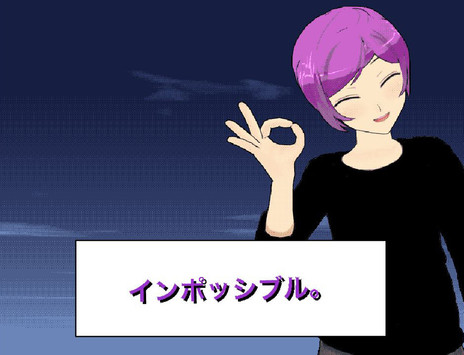
Frame from interactive content on Lttle Phnx's Pyrexia. Text translates as “Impossible”.
--
Extra Links
Black Forest Magazine interview with Fraser Austin (2013)
Radio NZ feature on Crystal Magic (2014)